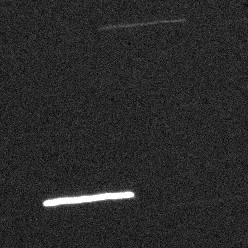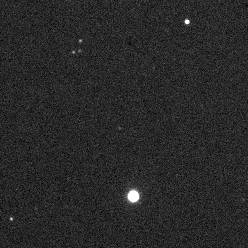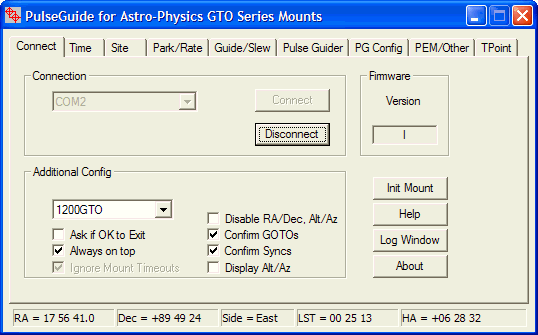|
|
PulseGuide v1.37 (latest version) - Click here!
PulseGuide is a stand-alone Windows (XP, Vista, Windows 7, 8, and 10) utility introduced in 2001. It provides control of Astro-Physics GTO400, GTO600, GTO900, Mach1, Mach2, GTO1100, GTO1200, GTO1600, and GTO3600 mounts. It derives its name from its most distinctive feature, pulse guiding, which can improve unguided tracking. Specifically it can help correct tracking errors caused by polar misalignment and refraction. You can also train PulseGuide to track objects moving relative to the stars, such as asteroids, comets, and the moon.
The pictures below are cropped 5-minute ST-10XE images (1.2 arc-sec/pixel) taken with a 1200GTO mount and AP155 refractor at 1085 mm focal length. The mount’s polar axis was purposely misaligned to show the capabilities of PulseGuide. The image on the left shows the extent of the mistracking in 5 minutes. Turning pulse guiding on results in a good 5-minute exposure:
 
In addition to pulse guiding, PulseGuide also has many useful utility features. With just a few exceptions, it supports the entire serial Astro-Physics command protocol.
PulseGuide requires a serial connection from your PC to your mount using a straight through DB9 cable. One end of the cable must have a female connector and the other end male. Cables as long as 100 feet or more should work provided the cable is made from high-quality shielded cable. Cables with twisted pair wires work best, such as those from Belden.

Some of PulseGuide’s features include:
- Fully supports the AP serial command protocol.
- Pulse guiding. This corrects for drift due to mispolar alignment and refraction. Pulse guiding is an idea originally suggested by Roland Christen (founder of Astro-Physics) and implemented in this application. It works by sending precisely timed serial commands that make the mount move faster in RA and/or Dec for a short period (hence “pulses”).
- Declination axis tests that you can use to check the health of your mount’s declination axis.
- With one button Unpark, automatically setting the time, time zone, longitude, and latitude without ever needing to plug in the hand controller. PulseGuide will even detect that your mount is not initialized and ask to initialize it.
- Unpark from one of the AP park positions or your own Alt/Az
- One-button Park feature allows you to park the mount at its current position, one of the AP park positions, or a user-defined Alt/Az.
- Set guide/slew rates.
- Buttons to move the scope conveniently.
- A status bar that shows the scope’s position in RA/Dec (or Alt/Az), the side of mount that the scope is on, Local Sidereal time, and Object Hour Angle.
- Set the tracking rate (sidereal, lunar, solar, zero).
- Delayed stop or park of the mount so the scope will not hit the pier if you fall asleep or forget to shut down the scope.
- PEM (On/Off, record with timer).
- Set mount to PC Time and set Time Zone.
- Set a Meridian delay so the mount will not flip on a GOTO command.
- Convenient Site management.
- GOTO/Sync to RA/DEC coordinates. STOP button to stop a GOTO, if desired.
- TPoint resynchronization. This is a useful tool if you are using Software Bisque’s TheSky with a TPoint model and lose synchronization because you moved the scope by hand.
- Focus control, including a counter to keep track of position.
- Reticle brightness control.
- Set mount backlash.
- Other miscellaneous features.
|



